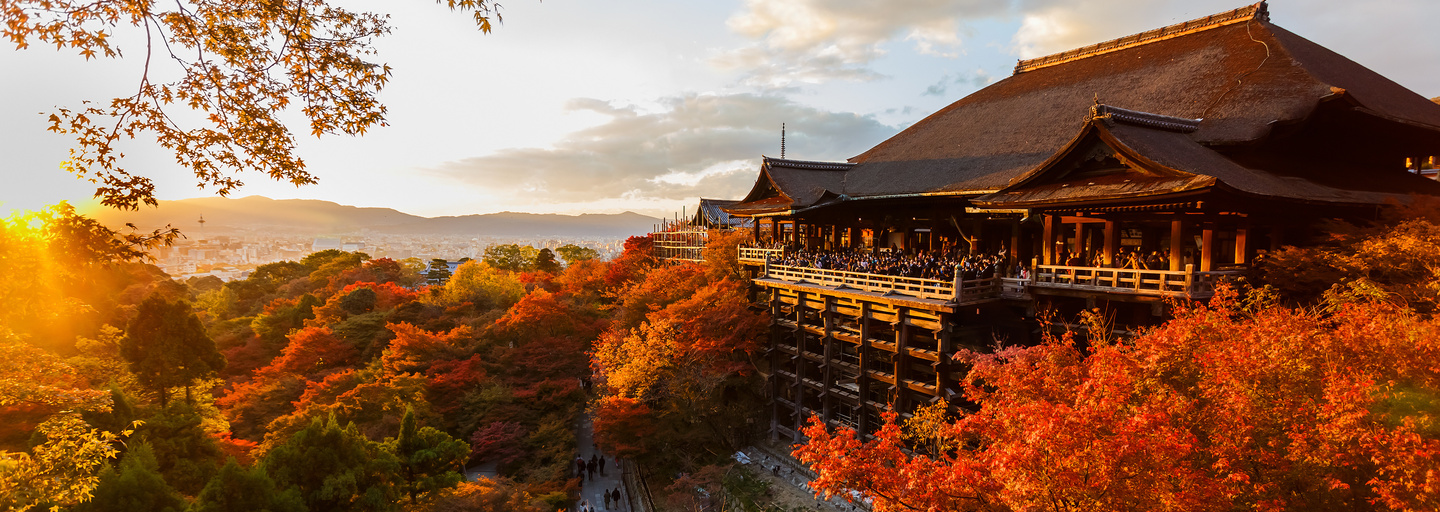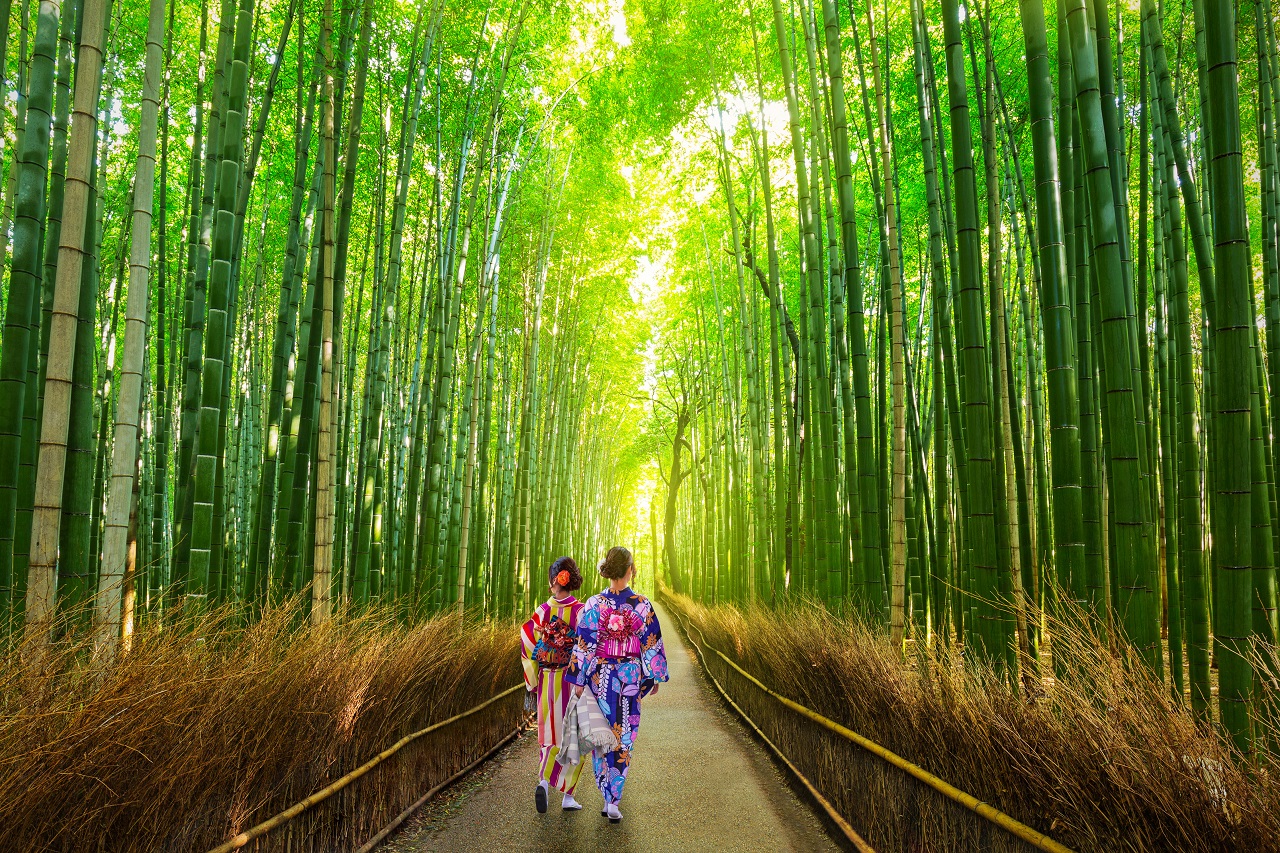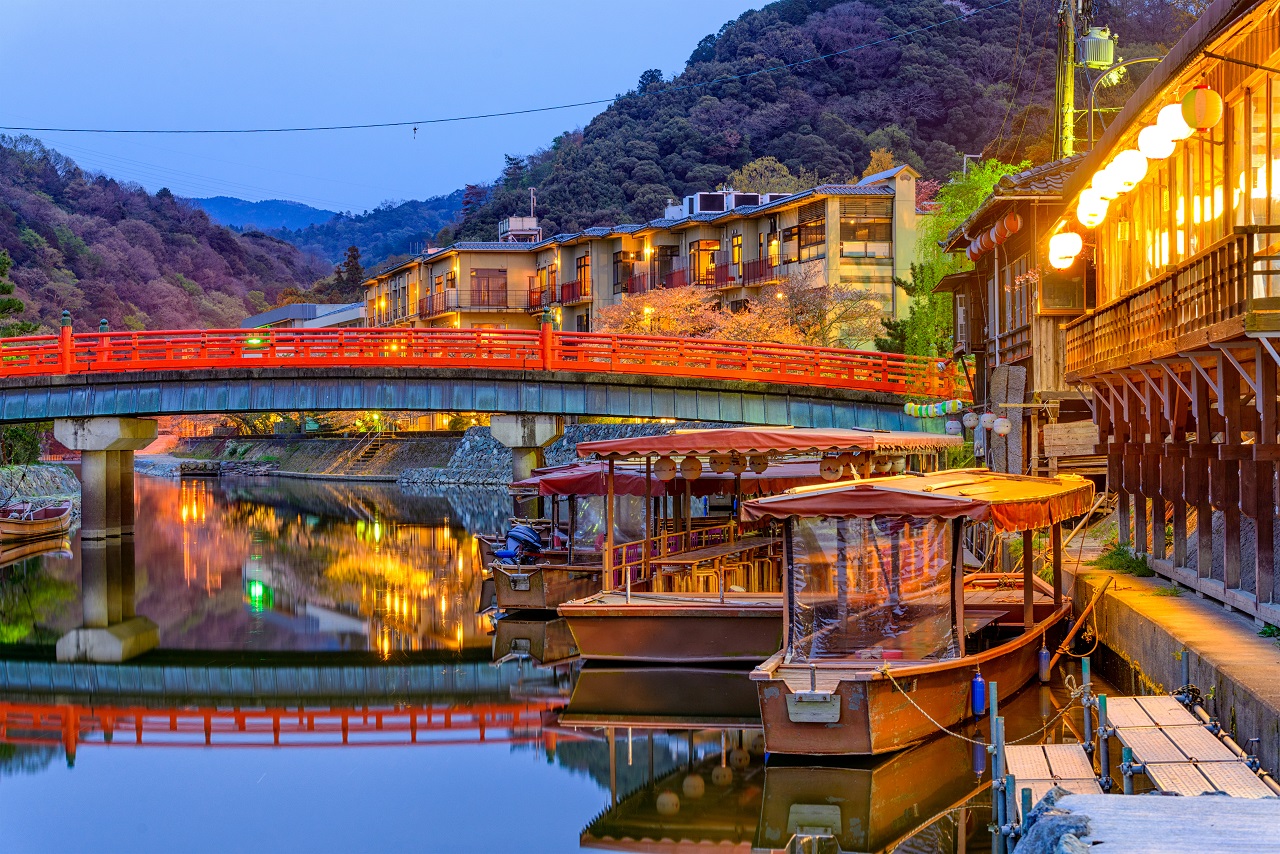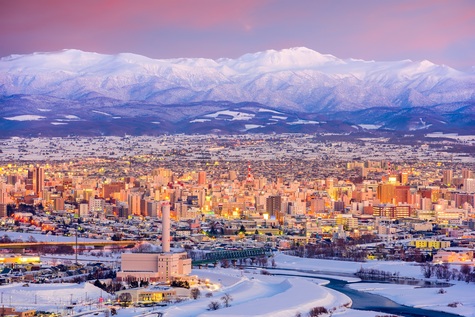
Kyoto destination guide
Kyoto travel guide - What to do, see and visit in Kyoto
Table of contents:
Introduction to Kyoto
The heart of Japan is also one of the country’s most loved cities. The home of many important cultural and historical sites, immersing yourself in Kyoto is to take a peek into the fascinating history of Japan. Originally the imperial capital city for more than 1000 years, Kyoto was first settled in the 7th century and remains the center for traditional Japanese culture. During its reign as capital, the Emperors of Japan also resided here until the capital was moved to Tokyo in 1869.
The city has a unique layout based on the Chinese dynasty capital, Chang’an (modern Xi’an), where the streets are laid out in a grid formation. Guarded naturally by mountains and rivers, the intentional grid layout also serves to ward away evil spirits. The main train station is located in the south of the city and easily connects you to the different stations and must see sites. Shijō, literally meaning Fourth Avenue, runs in the centre of Kyoto from east to west and serves as a vibrant, hip area of the city. Sanjou also runs east to west and offers quick access to the Gion district. Shichijo runs north to south on the grid pattern and will connect you to the city centre as well as Shijō and Sanjou.
For history lovers and for those wanting to deep dive into authentic Japanese culture, Kyoto will certainly be a must visit on your Japan visit. In addition to being home to a whopping 17 UNESCO World Heritage Sites, the unmistakable traditional feel of Kyoto has a charm that is unlike any other. A fusion of ancient temples, delectable cuisine and incredible religious architecture roll seamlessly together to create an unforgettably rich cultural experience.
The Best Kyoto Sightseeing
Kyoto is divided into Central, Eastern, Western, Northern and Southern which makes for easy navigation and accessibility. To maximise your time and things to do in Kyoto, focus on exploring one area at a time so that you can really sink your teeth into the diversity of each district. Whilst Kyoto isn’t as large as its bigger sibling Tokyo, the walking distances can be great. The Japan Rail Pass offers an affordable and efficient way of exploring the sites of Kyoto highlights. Central Kyoto
Ancient culture collides with the modern world in central Kyoto. Kyoto Station is your gateway to everywhere you would like to go within the city and beyond. Use this as your base to plan your Kyoto trip so that you make the most of your time in the centre. Home to two of the most important sites in the city, the Imperial Palace and Nijo Castle, Central Kyoto tourism has something for everyone. Although the centre of a city might drum up visions of a concrete jungle, this area actually has beautiful gardens and greenery dotted throughout as well.
Kawaramachi
The perfect meeting spot to begin your Kyoto itinerary is in Kawaramachi, the heart of Central Kyoto. As one of the busiest streets in the city, you are just a stone's throw away from fantastic shopping, must see sights and wonderful restaurants. From Kawaramachi station you can also travel onwards to Osaka.

The best way to explore the 400-year old Nishiki market is undoubtedly by taste. Over 100 stalls await dotted along a five-block-long street, offering an exciting array of local, fresh produce. From seafood to dumplings to pickled vegetables, this is the perfect opportunity to explore some of the fascinating and wonderful cuisine that Japan is famous for.
Imperial Palace
Until 1868 the Kyoto Imperial Palace was home to Japan’s Imperial Family. As if it has been frozen in time, step into the perfectly preserved palace to soak in the ambience of the Emperor and his families former residence.

A hidden gem of Kyoto, Nijo Castle was originally built by the first Shogun of the Edo period. Surrounded by spectacular gardens and a beautifully decorated interior, a visit to Nijo castle makes for a fantastic afternoon of learning about the intricate history of Japanese emperors.
Pontocho

Pontocho is, quite simply, magical. The narrow alley lined with traditional Japanese houses and restaurants comes alive at sunset and has a seemingly endless array of dining options. Home to many geiko houses and traditional tea houses, the charming streets are best explored in the evening.
Kyoto Station

More than a railway stop, Kyoto station boasts a shopping mall, cinema, hotel and several government buildings under its fifteen story roof. As well as servicing travel throughout the city, it’s also a major transportation hub connecting Kyoto with other major cities. Visitors arriving from Kansai Airport can easily access Kyoto and Osaka with the Haruka Express Train.

Kyoto Tower stands as the tallest structure in the city. Built in the 1960’s and dominating the skyline at 131 metres tall, a visit to Kyoto Tower offers exhilarating panoramic views. Breathe in the views from one of the best vantage points in Kyoto.
Japan is renowned for its innovative and cutting-edge railroad technology so a visit to the Railway Museum is a must for any locomotive enthusiasts. It’s said to be one of the greatest railway museums anywhere in the world and is just a 20 minute walk from Kyoto station.
Eastern Kyoto
A deep sense of spirituality flows through the area with traditions and buildings which has been upheld for centuries. Just North-East of Kyoto Station you’ll find the wonders of Eastern Kyoto. Religion and spirituality have been a cornerstone of Japanese culture for thousands of years and Eastern Kyoto is packed with temples, shrines and traditional neighbourhoods to explore. The key to enjoying Eastern Kyoto is to slow down. Breathe in the majesty of thousands of years of culture and fall in love with the charm of the historic districts. To truly experience the magic of the temples and shrines, it’s important to allow yourself plenty of time to soak in the atmosphere and understand the religion. Exploring the Eastern part of Kyoto is not intended to be a race, but a journey of discovery that deserves to be savoured.

Higashiyama
If Central Kyoto is the heart of the city, Eastern Kyoto is the soul with Higashiyama at the centre. Bursting with temples, gorgeous mountain views, quaint lanes, shrines and museums it offers a cultural richness like no other.
Ginkakuji - the Silver Pavillion

The baby brother to the Golden Pavilion, Ginkakuji oozes the Japanese aesthetic of understated beauty, wabi-sabi. It’s unconventional yet mesmerizing and a great site to stop at when considering when to do in Kyoto.
This pedestrian path offers a relaxing streamside walk which is said to inspire a zen state of mind. No matter the Kyoto weather, a stroll along the Philosopher’s Path promises benefits for the mind, body and spirit.

Yasaka Shrine is a prominent shrine with 1,350 years of history that is famous for being a sacred spiritual spot for love and connection. The shrine is full of character and is within walking distance between Gion and Higashiyama.
Kyoto National Museum
As the premier museum for Japan’s oldest and most distinguished art, the Kyoto National Museum should be at the top of your list if you are an art lover. Keep an eye out for the special exhibits which happen from time to time, they are phenomenal.
Gion

As the sun sets, the lanterns of the Gion district alight and the ambience of the evening warms the cobblestone streets. The best way to explore this beautiful area is on foot, taking in all the traditional wooden buildings and tea houses. If you’re lucky, you might even be able to see a geisha, or geiko as they are known in Kyoto, wearing a beautifully coloured kimono. Western Kyoto
It is said that the journey is just as great as the destination, and Western Kyoto is a testament to this. From exceptional examples of natural beauty to an exploration into how spirituality is so important to Japanese culture, a visit to Kyoto isn’t complete without a venture into the West. Trade in the busy city and the crowds of people for stunning nature and absolute serenity. Japan is extremely unique in the sense that it offers a stark diversity. In the morning you might be in awe of the imposing bamboo forest and by the afternoon you can be back in the city centre, people-watching thousands of passer-bys as you devour the best ramen you have ever tried.

To take your Instagram to the next level, the Bamboo Grove must be included in your Kyoto visit. The towering bamboo stalks feel like you have been transported to another planet and make for the perfect stroll and photo. Whilst you’re there, be sure to walk the popular Togetsu-kyo bridge or check out the wild Japanese macaque monkeys (the views at the top of the mountain are also amazing!).

Katsura Villa is one of two imperial villas built in the ancient capital. It was constructed in the early 1600’s and is one of the finest examples of Japanese architecture and garden design.
Sagano Railway
Explore the exceptional beauty of Western Kyoto by rail. The Sagano railway, also known as the Sagano Romantic train, snakes for 25 minutes through lush scenic countryside.

Tenryuji Temple is the most important temple in the Arashiyama area. Built in the 1300’s, the zen temple sits at the foot of stunning mountains and features teahouses and serene gardens.
Northern Kyoto
Venture a little further North to escape the crowds and experience the rich, colourful natural wonders that Kyoto has to offer. Authentic, traditional villages and the friendliest locals you might ever meet await just beyond the northern city border. The North has bountiful natural wonders for you to discover. Whether you choose to walk, hike, cycle or swim, you will certainly return to the city refreshed with an appreciation for the beauty of the local area.
Kibune
Kibune village might be Kyoto’s best kept secret. A 30 minute train-ride from Kyoto, it welcomes a serene and unique city-escape. If you’re in the mood for mountains, rivers, authentic cuisine and friendly locals; Kibune has it all.

Kurama is known as the birthplace of Reiki and for having one of the most easily accessible hot springs from Kyoto. Add this misty mountain paradise to your Kyoto itinerary for the perfect mix of nature and culture.
Shugakuin Villa
Originally designed as a lavish retreat for the Imperial Family, a visit to the largest Imperial villa in Kyoto takes an interesting look into the history of Japan.
Quaint yet beautiful, Sanzenin is a sacred temple that was founded in 806 when monk Saicho introduced the Tendai school of Buddhism to Japan. It takes just over an hour to reach from Kyoto station.
Takao is a tiny village nestled amongst the Kitayama mountains, known for its many cycling and hiking routes. When Kyoto weather turns to autumn hues, Takao is especially spectacular and worth a visit.
Southern Kyoto
The south of Kyoto is a treasure trove of temples, shrines, UNESCO world heritage sites and gardens waiting to be explored. The southern part of Kyoto is divided in two by the Kamogawa river which runs towards the Katsura river which is a good point of reference. Alongside the important religious structures, the mountain trails in the south make for a fantastic half-day trip. For a well-rounded Kyoto guide, be sure to include a few stops in the south to your Kyoto itinerary.

As one of the oldest cities in Japan, Uji is bursting with history and tradition. A myriad of tea fields and tea shops await just under 30 minutes from Kyoto station.

Top Kyoto travel tip alert! Head to Fushimi Inari first thing in the morning to avoid the crowds that inevitably flock there later in the day and enjoy a postcard-perfect hike to the top. Made up of thousands of Torii gates that weave through the forest, it draws people of all ages who come to pray for bountiful crops, success in business and to find love.

Just a 15 minute walk from Kyoto station lies the tallest wooden pagoda in Japan, Toji Temple. As well as being a UNESCO world heritage site, numerous national treasures are also kept here.

The ‘Temple of Flowers’ is spread across Daigo-San mountain, originally being built in 874 by a Buddhist monk. The impressive grounds of the temple is one of the most popular cherry blossom viewing spots in Kyoto.
Kyoto sightseeing is simply a traveler's delight. The city oozes its own unique charm, drawing you in with a cultural richness that can’t be duplicated. For a deep lesson in Japanese history, a scrumptious tasting board of local cuisine and jaw-dropping natural beauty, make sure to visit Kyoto on your next trip to Japan.
See also

Sapporo Destination Guide
일본에서 가장 젊은 도시 중 하나로 알려진 삿포로는 맥주,라면, 게, 스키 및 거대한 얼음 조각상이 열리는 매년 삿포로 눈 축제로 가장 유명합니다.

Mt Fuji Destination Guide
후지산은 틀림없이 일본의 상징입니다. 고독한 산은 단지 아름다운 경치 이상으로 일본의 물리적, 문화적, 정신적 지리에 기여합니다.

Nikko Destination Guide
수세기 동안 신도 및 불교 산 숭배의 중심지로 알려진 닛코 국립 공원은 아름다운 산악 풍경, 호수, 폭포, 온천, 야생 원숭이 및 하이킹 코스를 제공합니다.

Kyoto Destination Guide
교토는 역사적으로 일본의 수도이자 문화 중심지였으며 풍부한 문화와 전통을 자랑합니다. 교토에서 할 일,보고, 경험할 수있는 최고의 것들에 대해 알아보십시오.